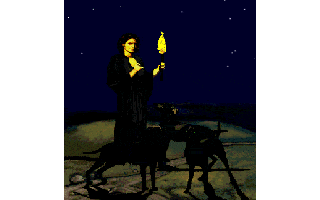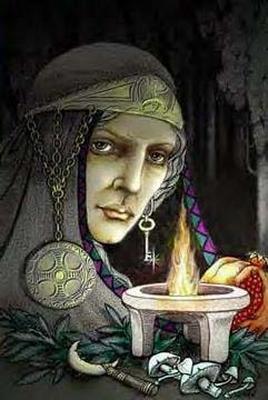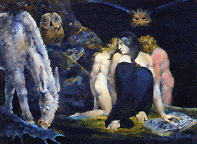|
Hecate (Hehk-ah-tee;
Hee-kah-tee) is
probably
the most famous of the Greek deities associated with magick.
According
to tradition, she is either the daughter of Zeus (Zoos;
Zyoos) and Demeter (Dee-mee-tuhr;
Dehm-uh-tuhr);
Zeus and Hera (Hair-uh; Huhr-ah; Hee-rah);
or the Titans (Tigh-tanz) Perses (Puhr-seez)
and Astria
(ass-tree-ah).
The later being
the most likely since she is an ancient Goddess. Though she is of
uncertain pedigree, it is clear
that she is a Titaness of Thraycian (thray-see-an)
origin.
From
the earliest
times she ruled the moon, the earth and the sea.
She is known as Hecate of Heaven, Earth and Hell for obvious
reasons.
Amongst her blessings were victory, wealth, wisdom and successful
hunting
and sailing. However, she only bestowed these treasures upon
those
mortals whom she deemed worthy. Her gifts were not idly handed
out.
She was the sole Titan who retained full power and priveleges under the
iron rule of Zeus. She was honored and revered by all
immortals.
There is some speculation as to why she was so priveleged to keep her
full
potential once the Olypians (Oh-lihm-pee-anz)
began their rule. One source suggests that this was because she
was
not a careless Goddess and was cautious as to which mortals received
her
blessings and which did not. It may also be because she assisted
the Olympians in the war against the Gigantez (Gigh-gan-teez)
or Giants. Or even due to her refusal to become involved in the
war
between the Olympians and the Titans. Which ever the case may be,
she did not decline in her potency after the Olympians came into
power.
In
time, she became
equated with many other Goddesses. As Queen
of nature, fertility and plenty she became associated with Demeter,
Rhea (Ree-ah; Ray-ah) and Cybele (Sigh-behl-lee;
Kigh-behl-lee); as a huntress, protectress of children and
Goddess
of the moon she was associated with Artemis (Ahr-tee-mihs),
Diana (Digh-an-ah; Dee-an-ah) and Selene
(Suh-lee-nee;
See-leen; See-lee-nee; See-lee-nah; Suh-lee-nah; Suh-leen).
Some accounts even credit her as being Persephone/Proserpine/Proserpina
(Puhr-sehf-foh-nee,
Proh-suhr-pihn-nee, or Proh-suhr-pee-nah
respectfully applied)
in her most terrible aspect, though it is most likely this just became
on of her many names due to her relationship with the underworld.
Hecate and Persephone were supposedly great friendsand many reliefs
show the two very frequently together and often with Hermes (hur-meez)
with whom the latter Hecate has children. It is not uncommon for
such to assume their friend's name. All of these things have lead to a
great
deal
of confusion, particularly for the idle researcher as many tend to
except
that Hecate is an aspect of one of the other deities rather than an
ancient,
independant and potent Goddess. The fact is that she is a very
ancient
entity which predates many of those whom she has been associated with
over
the years and is not merely an aspect or an absorbed divinity.
She
has had many aspects and names, which we will address shortly.
Originally,
it seems
that she was a virgin, lunar, sea Goddess.
There are many myths regarding her advancement in power and
knowledge.
It is clear that she had a ravenous hunger for learning and
growing.
In a myth regarding her and Hera, Goddess of fidelity, protectress of
women
and childbirthing. The young Hecate is said to have grown curious
regarding childbirthing which disturbed Hera thoroughly. Hera had
once been a vestal (veh-stahl) Goddess
herself,
until her brother (and later husband) appeared to her in the form of a
wounded sparrow which she clutched consilingly to her breast.
Zeus'
deception spoiled Hera's purity, and while she retained the title as
Queen
of the Vestal Virgins, she was not one in the least. So Hecate's
curiousity upset her thoroughly as she new the dangers of such
inquiries
to a virgin Goddess. Hecate's curiosity would not abate, so
secretly
she spied on Hera while she added a woman in delivering her child and
Hecate's
purity was marred. It is through this that she became known as
Hecate
of the earth as well as Goddess of nature and protectress of
children.
It is believed Hera never over came her anger for Hecates
actions.
In
later Greek
history it is stated that Hecate and Helios (Hee-lee-ohs)
were the two sole witnesses of the abduction and rape of Persephone by
Hades (Hay-deez), God of the
Underworld.
The legend says that she left her cave with torch in hand to aid
Demeter
(Persephone's mother and according to some legends Hecate's mother
also)
in her search for the missing Goddess. It does not
say why she
did
not tell Demeter what she had witnessed, but, it is assumed that she
had
seen an opportunity for advancement and decided to benefit herself by
Hades'
actions. Once Persephone had been found, and arrangements made
for
her to remain in the Underworld with her new husband for part of the
year
and spend the other part on earth with her mother, Hecate remained in
the
Underworld as Persephones friend and companion. This eventually
gave
Hecate formidable powers over the Underworld. It is through these
events that she became known as Hecate of Hell and as a Goddess of
purification
as well as protection. missing Goddess. It does not
say why she
did
not tell Demeter what she had witnessed, but, it is assumed that she
had
seen an opportunity for advancement and decided to benefit herself by
Hades'
actions. Once Persephone had been found, and arrangements made
for
her to remain in the Underworld with her new husband for part of the
year
and spend the other part on earth with her mother, Hecate remained in
the
Underworld as Persephones friend and companion. This eventually
gave
Hecate formidable powers over the Underworld. It is through these
events that she became known as Hecate of Hell and as a Goddess of
purification
as well as protection.
It
is unclear as to
whether her loyal hellhounds were acquired at this
time or whether they had simply always been a part of her
entourage.
Nevertheless, she did become associated with a vast array of forboding
characters from her connection with the Underworld. Including
spectres,
ghosts and ethereal entities in general. Not only did she preside over
them, ruling them compleatly, but, she was also their tormentress when
the occassion arose.
Hecate
is remembered
today as a dark Goddess who at night sent out daemons
(a word which originally meant "spirits;" neither beneficial nor
malefic
specificly) and phantoms, taught magick and sorcery to brave mortals
and
who wandered about after dark with the souls of the dead accompanied by
the baying of dogs and hellhounds. It was believed that only dogs
could spy her nocturnal passing, so whenever dogs were heard to howl it
was believed that Hecate was near. She was the Queen of the
night,
of ghosts and shades as well as other fearsome beings. The bronze
clawed
Harpies (Hahr-peez) were also under her
reign
and dwelt in her dominion in the Underworld. She was said to be
the
cause of nightmares and insanity. Perhaps why the moon is said to
turn people into "LUNAtics." It is a fact that crime, suicides and
other
strange occurrences are reported more during the fullmoon than during
any
other of it's phases. She was so terryfying and frightening to
the
ancients that the referred to her as Aphrattos/Aphrottos,
(Ah-frah-tohs;
Afra-tohs; Af-roh-tohs) "the nameless one" or "the unnameable," as well
as Pandeina, "the all-terrible."
She
was the Goddess
of the dark of the moon; the destroyer of life.
In one myth, she turns into a bear (or a boar, of which it is never
quite
clear) and kills her own son, Mormo, then brings him back to
life.
These seemingly was a form of selfless sacrifice and in some Hecatean
sects
he too is honored and revered for his death and resurrection
presumeablly
symbolic of the dying king. Many refer to him as the first
"living
dead" and there is some evidence to support this which is discussed at
more length further on in this text. In her dark aspect, she
wears
a necklace of testicles; her hair is made of writhing snakes which can
petrify like the Gorgons. She was a terrible sight to behold in
this
form. Both frightening and viscious. Her hellish revenue included
the Empusa (Em-pyoo-sah), a hobgoblin
like
creature; the Cercopsis (Suhr-kohp-sihs),
a
sort of poltergeist and those named for her son, the Mormo (Mohr-moh),
a group of flesh eating ghouls.
However,
this is not
her only guise. She is often depicted as
a normal woman, most often common, though sometimes lovely. She
is
also seen as a woman with three heads and with three sets of arms which
is a common visage todays witches ascribe to her. This later form
today is associated by witches as the images of the maid, mother and
crone
representative of the three lunar cycles. Though commonly, modern
witches primarily view her as the crone alone naming the other two
faces
as othe Goddesses such as Artemis as the maiden and Demeter as the
mother.
There was also another triple headed image of her bearing the faces of
a dog, a ram and a serpent (though sometimes that of a horse replaces
the
serpent) all on the body of a woman. Her home is alternatively
described
as being a cave, a place amongst tombs or other places of the dead, or
a site where blodd was shed by a murderer.
Initially
her worship
was widespread, especially at Samothsrace (Sam-mahths-rayss),
Aegina (Ee-gee-nah), her sacred city
where
festivals were held to her on the eighth of August; Argos (Ahr-gohs),
Hera's sacred city and Athens (A-thenz),
Athena's (Ah-thee-nah; Goddess of strategic war,
crafts, wisdom
and culture) sacred city from which it was named. Many
homes displayed statues of Hecate either inside or just outside the
home,
by the front door hoping to invoke her protection. These images
also
appeared at crossroads (which were sacred to her) and it is believed
that
one would suffer greatly who harmed a traveller who rested by her image
at such a site. There is some speculation that the Hecataea (Hehk-ah-tee-ah;
Hee-kah-tee-ah) were also consulted as oracles. The
three
headed figures often carried an assortment of weapons which included
swords,
daggers, torches, whips and snakes. This is a common image still
applied to her today.
At
the end of each
month, her worshippers set out dishes of food for
her by the statues at crossroads and by their front doors (typically at
the statues feet on the ground). This meal typically consisted of
fish, honey, onions and eggs, but may have also included garlic which
is
considered sacred to her. Those seeking to appease her, often
made
sacrifices of chicken hearts and barley cakes which were left beside
there
doors. It was considered to be a good omen should a dog
(especially
a black one) eat this sacrifice. Other sacrifices were also common to
her
worship. These were usually performed at crossroads and consisted
of female black puppies, she-lambs or goats and human infants, also
female.
The animals are typically believed to have been black in colour.
The sacrifices were held at the fullmoon. White children were typically
sacrificed face up by cutting the throat while black children were
likely
offered face down so that their blood might fall to the earth
quickest.
She was VERY partial to black. Her prayers were likely performed
on ones knees with palms open and facing up with the head raised
towards
heaven or with the palms down and the head lowered to the Underworld
depending
on either location of the worshipper or in what way they were praying
to
her.
She
was also the
patroness of the medieval witch covens who worshipped
her in the secret rites. Though it is unclear whether it was a
revival
or survival of her cults that appeared at this time. It is
certain
that her cults out lasted those of her fellow Greek divinities.
Her
cults were centred originally in Lagina (Lah-gee-nah)
and are known to have existed circa 800 BCE through Christianization,
circa
400 CE though it is probable that her worship dates much farther back
and
may have survived longer than recorded. The Goddess Herodias is
believed
to be an aspect of Hecate and others suggest that she strongly
influenced
(at least Hecuba (Hehk-yoo-bah) and
Hepzebah (Hehp-zih-bah) which may even
give her biblical
associations. She has been known by many names that have either
been
hers uniquely, or as mentioned above have been absorbed by her.
These
names include Trivia (Trih-vee-ah; Try-vee-ah
three-roads)
as Goddess of the crossways and protectress of travellers, Pandeina (Pan-dee-nah)
"the all-terrible," and the names of most any lunar Goddess.
Hecate
itself is of uncertain origins or meaning. Some suggest it means
simply,
"100," refering to the 100 months of the great lunar year. Others
suggest it means "one from afar," "one who stands aloof," or "influence
from afar." There is no actual way of knowing for certain, though
we do know that similar words in Greek are ascribe with both
meanings.
However, there is also considerable reason to assume that it may not be
Greek in origin at all. Gnostic poetry from Alexandrian Aegypt
has
survived the harsh passage of time, though fragmented, it is clear that
it refers to Hecate in which she is venerated as "the Great Mother,
life
of the universe." This may suggest that she influenced or perhaps
even was the same as the Aegyptian Goddess Hekat.
Shakespeare
included her in Macbeth as the mysterious patroness of the
three "weird sisters" or witches who invoke her. This has
seemingly
encouraged the continuance of her worship as well as impressed her in
the
minds of most people as the reigning omnipotence of witches and
magick.
She has since bcome the subject of many artists, writers and
poets.
Most notably she appears in Hesiod's (Hee-sahdz)
Theogeny. Euripides (Yoo-rihp-ih-deez),
the Greek poet, calls her "Queen of the Phantomworld." As well,
she
has become the subject of many incantations and spells. She was
invoked
using a symbol of the cresent with two points up and a third point at
it's
centre. One such petition for her patronage (with reference to
sacrifice)
was recorded in the third century by Hypolitus (High-poh-ligh-tus;
High-pahl-ih-tuhs; Hih-pahl-ih-tuhs) in the work Philosophumena (Fihl-ahs-oh-foo-mee-na) as follows:
"Come,
infernal, terrestrial, and heavenly
Bombo (Bahm-boh; another name for Hecate),
Goddess of the broad roadways, of the crossroads, thou who goest to and
fro at night, torch in hand, enemy of the day. Friend and lover of
darkness,
though who doest rejoice when the bitches are howling and warm blood is
spilled, thou who art walking amid the phantoms and the place of tombs,
thou whose thirst is blood, though who doest strike chill fear into
mortal
hearts, Gorgo (Hecate, perhaps but certainly
referring
to the Gorgons), Mormo, Moon of a thousand forms, cast a
propitious
eye upon our sacrifice."
She
was most notably
a frequent lover of Hermes (Huhr-meez)
as well as other Gods. Hecate also had many children most of which were
monsters. Scylla (Sih-lah) for
example.
However, as one myth explains, she was once a beautiful see-nymph until
she became the romantic rival of Circe (Suhr-see)
who transformed her into a monster. As Scylla's mother Hecate was
called
Cratais or Crataeis (Krah-tay-ihs; Krah-tee-is).
She is credited (though sources have varying opinions) as being either
the mother or aunt of Medea (Mee-dee-ah)
and
Circe, both are prominent sorceresses in Greek history. Scylla
was,
and actually still is, a dangerous stretch of waters near Greece that
has
long claimed the lives of many sailors.
In
modern witchcraft
she is associated almost exclusively with the lunar
trinity mentioned above. In this triple Goddess aspect, she
appears
a lot less fearsome than history paints her. She rules over the
waning
and dark of the moon, a two week period that is best for magicks
dealing
with banishings, releasing, planning and introspection. Like
Persephone,
she has become a Goddess of the subconscience and of scrying.
Today
she is invoked for justice and protection whereas she was once invoked
for revenge and punishment. She is, as she has always been, a
mysterious
and complex figure: Goddess of wealth and fortune; mistress of magick
and
sorcery; protectress of youth and children; queen of the night, the
moon
and the seas; huntress, protectress, tormentress. As kind and
loving
as she can be cruel and unmoveable.
She is credited
with the discovery of aconite (),
one of her sacred herbs which was once used in flying ointments. It is
said that it grew from the soil of the Underworld watered by the fallen
froth and spittle of Cerberus (Suhr-buhr-uhs).
It was considered to be the first poison.
The
following associations have been attributed to her
Animals
|
Fumes
|
Herbs
|
Minerals
|
| Dog |
All sweet,
virginal odors
|
Aconite
|
Silver |
| Horse |
aloes |
almond |
|
| serpent |
camphor |
chickweed |
|
| woman |
civet |
garlic |
|
|
honey |
hazel |
|
|
menstrual blood |
mandrake |
|
|
myrrh |
moonwort |
|
|
storax |
mugwort |
|
|
peppermint |
oak |
|
|
|
onion |
|
|
|
opium poppy |
|
|
|
ranunculus |
|
Stones
|
Tarot
|
Tools
|
| Crystal
(quartz) |
Threes |
Bow and Arrow |
| Moonstone |
High Priestess |
Robe Of
Concealment |
| Opal |
The Moon |
Yoni |
| Pearl |
|
|
| Star Sapphire |
|
|
This
list is general, in no way compleat and likely bound to
meet with
contridiction.
Hecate was a reasonably common
subject for ancient sculptors
and appears
in many forms of art including reliefs.
|





